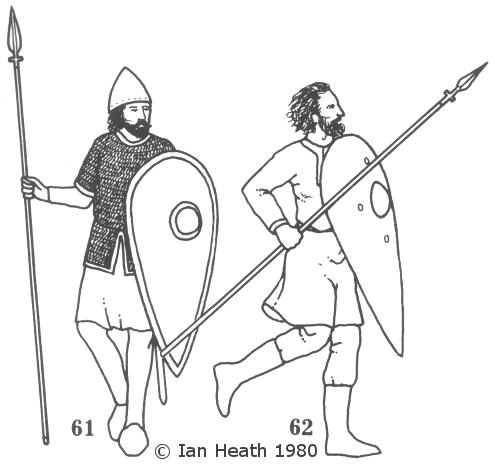|
|
OTTONIAN INFANTRYMEN
An extract from Armies of the Dark Ages 600-1066
by Ian Heath

61. OTTONIAN HEAVY INFANTRYMAN
This figure is from a Codex Aureus ms. of c. 983-991, showing the kite-shaped shield in Europe for the first time.
It is convex, of wood and leather with a boss that no longer covers a handgrip. In shape it is not yet as long or tapering as those of the
Bayeux Tapestry, and it may represent a transitional type between those and the earlier type described under
note 13
(some of which also appear in late-10th and early-11th century western art).
There is no evidence in the Aureus ms. that it was developed for cavalry as is so often claimed, being shown there in use only by infantry.
It was probably adopted from the Byzantines during clashes with them in Italy in the last decades of the 10th century.
It was also at about this time, c. 1000, that a new type of sword began to appear, with a more tapering blade and better balance.
The mace, sometimes wielded in both hands, also begins to appear in western sources in the second half of the 10th century.
62. OTTONIAN MEDIUM INFANTRYMAN
Also from the Codex Aureus ms., he has no obvious secondary armament though a knife or scramaseax would probably have been carried, or even a sword.
Others would have been like those described under 46,
115,
130 and
131, armed with bow, crossbow or javelins.
[Based on the Codex Aureus of Echternach, 1030-1050AD,
Germanisches Nationalmuseum in Nuremberg, Germany]
|

